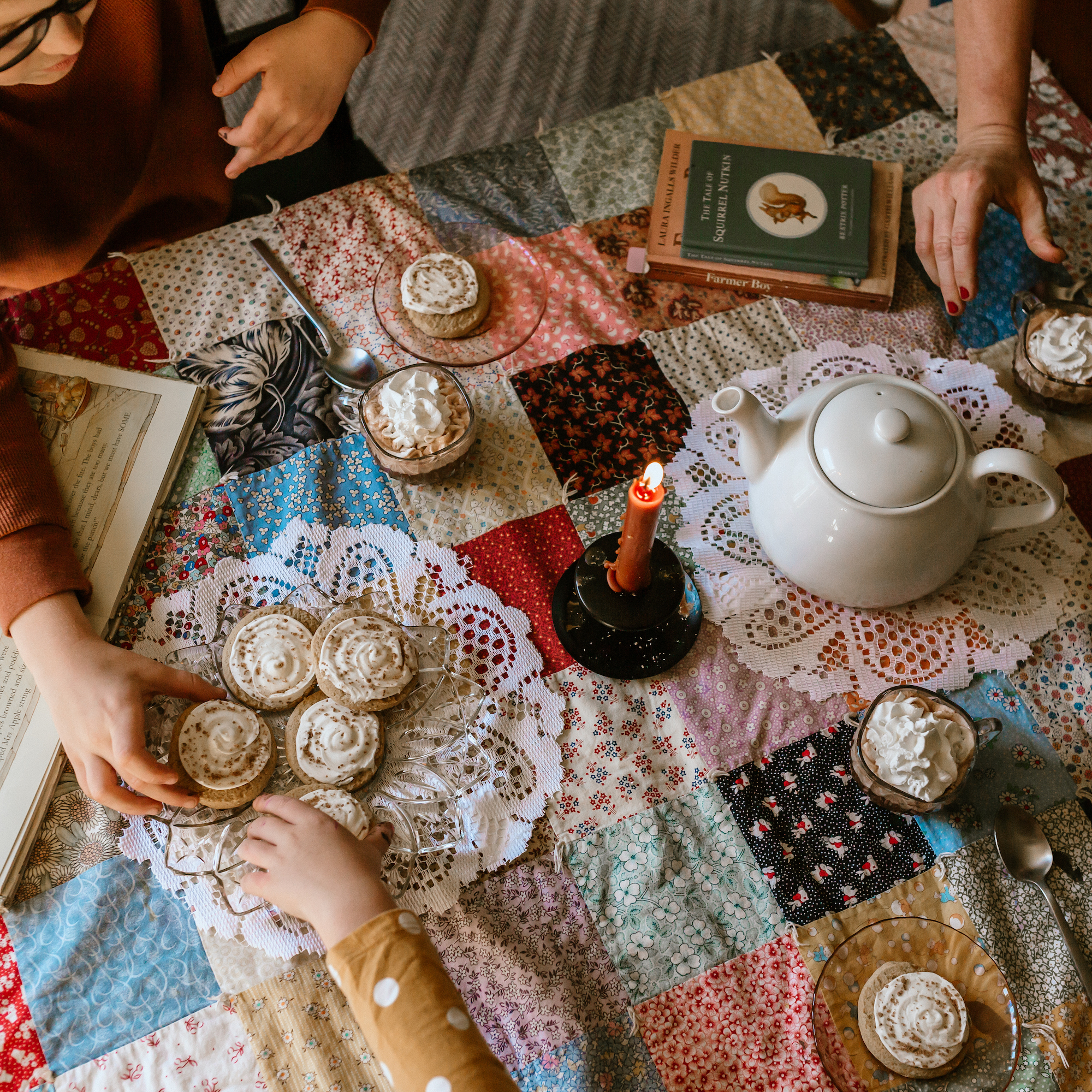Although we homeschool year-round, each summer we take a few weeks off in July or August to make space for a fresh, new start date for fall.
During this period, I like to review how the previous year went and decide if we will make any changes for the upcoming year. If I am making any big curriculum shifts, I implement any changes or new curriculum when we start back in the fall.
This autumn I am excited about the shifts we are making! We will start our “new school year” at the beginning of August. I am especially excited this year to welcome my third-born child, Huck, into formal schooling as he turns 6 in August!
In this blog post:
- Our homeschool style and philosophy
- Early learning: What we used for homeschool preschool and kindergarten
- Our first grader’s homeschool schedule
- First grade homeschool curriculum choices
- Other favorite curriculum choices for first grade
Our homeschool style and philosophy

In my homeschool, a lot of our schoolwork is done “family-style.” Family-style learning means that we use curricula where my children can share in learning together at different ages and levels. While my children also have work they do independently that is tailored to their levels, I try to choose the majority of our curricula that can easily be tailored to all of my children. This makes lesson planning more stream-lined and fosters sibling bonding as we study the same things at the same time.
First grade is unique because my son, Huck, is really learning to read this year, so that requires some more intentional one-on-one focus. We also individualize math for all of my children because they are on different levels.
While I do not subscribe to one specific methodology of education, I do lean toward Charlotte Mason principles. I value learning through living books, life experiences, and educating the whole child (not only the mind). Take this Homeschool Style Quiz to see what learning styles fit your family best.
Early learning: What we used for homeschool preschool and kindergarten

For preschool-aged children, I do not focus on formal learning. Instead, I gently invite them into our family-style learning environment, like our family devotionals, nature study, and read-alouds. I focus on creating an environment for them to grow in their love for literature, creative play, and practical life skills.
Last year, I eased my 5-year-old son into some gentle kindergarten work to prepare him for formal schooling. Before age 6, I do not expect my child to participate in structured learning, but offer activities as invitations. I focus on hands-on activities that are tailored to their interests and believe that much of their learning comes from how they spend their time during the day, like playing outside or learning how to help in our home. We also sprinkle in some gentle letter and number work when they are interested.
Our first grader’s homeschool schedule

For first grade, I plan to have Huck join in on formal lessons about three hours a day, four days each week. We usually do school lessons on Monday through Thursday, and spend Fridays outdoors with our homeschool nature group.
Each day he will do:
- Family devotions: 30 minutes
- Morning Time (art, poetry, nature, literature): 1 hour
- Core subjects (math, handwriting, reading): 1 hour
- Read-aloud, oral narration, and notebooking: 30 minutes
There hasn’t been a year of homeschooling where I used everything I intended to use at the start of the school year. Some things get ditched altogether and others modified. I add things, remove things, and shift as we go. This is the beauty of home education – take this overview with a grain of salt. This is my starting plan!
Also, I know that what works for me as a homeschool teacher or for my children won’t necessarily work for you! This is a peek into the way one family is homeschooling. I hope this helps you find what fits you and your home best.
First grade homeschool curriculum choices
Here are our homeschool curriculum choices for first grade.
Family devotions

For family Bible devotions this year we are revisiting Our 24 Family Ways: A Family Devotional Guide. We are using this primarily because my younger children are now at an age where they can understand it more.
The book’s premise is that you as a parent are creating a culture in your home of how your family thinks and acts. Based on the idea that Christians are called to “train up a child in the way he should go,” the author maps 24 ways to teach and instruct children. I loved this idea because I felt like it was giving clarity and verbiage to the character traits I want my children to have. We have now used this devotional twice and I can’t recommend it enough!
We will also use Rooted Family Bible Curriculum, which incorporates Bible readings, discussion, scripture memorization, prayer, hymns, art study, poetry, and simple hands-on connections. I designed it to incorporate beauty subjects with Bible study. The curriculum is centered on declarations about identity in Christ and their choices to live a life devoted to God and is great for ages 6 and older.
Homeschool Morning Time

In our homeschool, we do Morning Time four times a week. This year for my first grader it will include calendar and weather charting, hands-on letter and number practice, literature, and nature study.
Calendar and weather charting
We start Morning Time by using the Morning Time Bundle, which includes calendar work, weather charting, and more.
Hands-on letter and number practice
Sometimes he will use the Wonder of Nature Collection while I read aloud during Morning Time. This offers simple letter formation activities with dry erase markers. We like to pair the Wonder of Nature Alphabet Print Cards with the Alphabet Sheets to practice letter formation in different ways, including writing the letter or forming the letter with playdough. He will also use the Wonder of Nature Numbers Bundle to practice number recognition and counting during Morning Time. I love that all of these can be in a Morning Time Menu and used independently.
Read alouds with science, history, and nature study connections
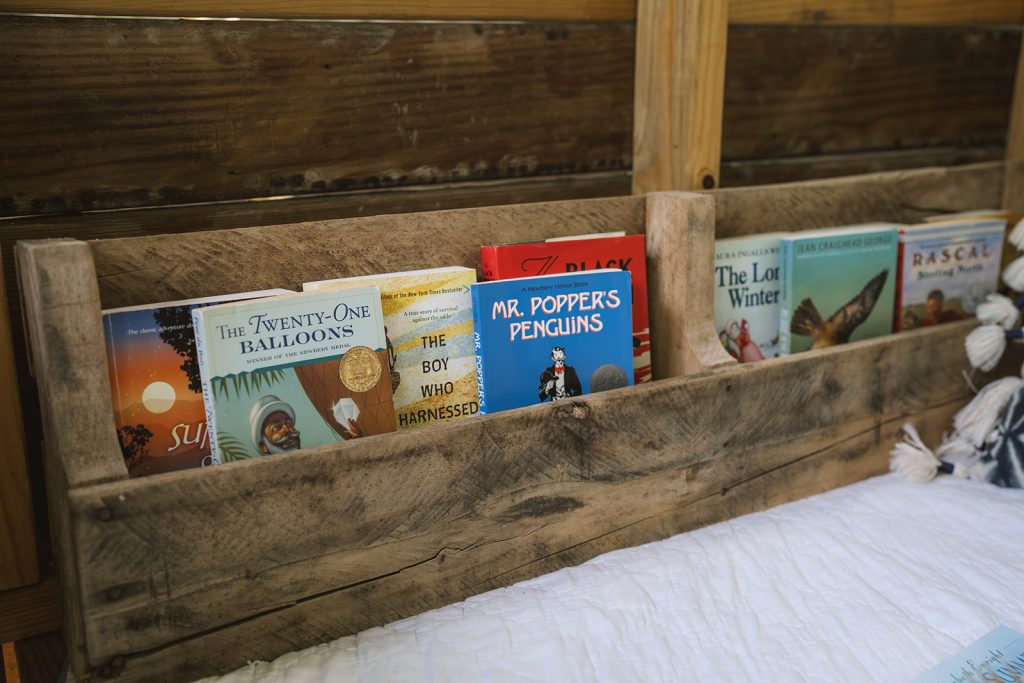
This year I am excited to use Treehouse Book Studies as a literary element during Morning Time. Each morning I will read one or two chapters from the book selection. Then we will add elements from the guide to expand on the book and connect it with other themes related to the book’s theme. This could be watching videos that talk about the book’s historical elements, sketching a topic we read about in the story, or reading more picture books about ideas presented in the story.
For a first grader, I focus on narration by having Huck tell pieces of the story back to me and interacting with his siblings in answering questions about the story. He will also draw pictures and complete simple notebook pages about themes that we are learning through the book. We will also bake together and do other interactive activities from the lesson guide.
We will meet with a group of friends once a quarter to celebrate reading the book and do presentations and group activities.
First grade nature study

We will rotate Treehouse Book Studies withTreehouse Nature Study during Morning Time. My family has loved using Treehouse Nature Study for years. We will use the curriculum’s selections for seasonal poetry, art, book lists, notebooking, and other hands-on projects related to nature themes.
First grade Language Arts and Bible-focused history
Huck will use a curriculum I used and loved using with my older children, My Father’s World: Learning God’s Story.
This curriculum is nostalgic for me because we used it for my older two children at this age. We only use the Language Arts and Bible portion of the curriculum, which includes Bible stories, copywork, writing, phonics, and reading. The curriculum guides children to learn to read through Bible stories and by the end of the year they have read this Bible reader that summarizes Bible stories in the Old and New Testament. My son will also create a Bible Notebook, writing short narrations of the Bible stories and illustrating them, and an illustrated Bible timeline.
- Handwriting and copywork: My son will also continue using Learning Without Tears handwriting books and copying selections of poetry, Scripture, and excerpts from books.
- Literature and notebooking: Huck will practice notebooking with literature themes from Treehouse Book Studies. This may look like him summarizing a few things he’s learned about a topic we’re studying through the book and I will write down what he says. Then, he can copy the words down in his notebook and illustrate. As he grows, I would like to see his notebooking become more independent this year.
- Additional writing: Each Monday my children participate in Mail Monday, which is an informal way to practice writing skills. Huck will join in this as well.
- Phonics and reading: Huck will continue using Explode the Code, as well as reading aloud to me from various early readers.
First grade math
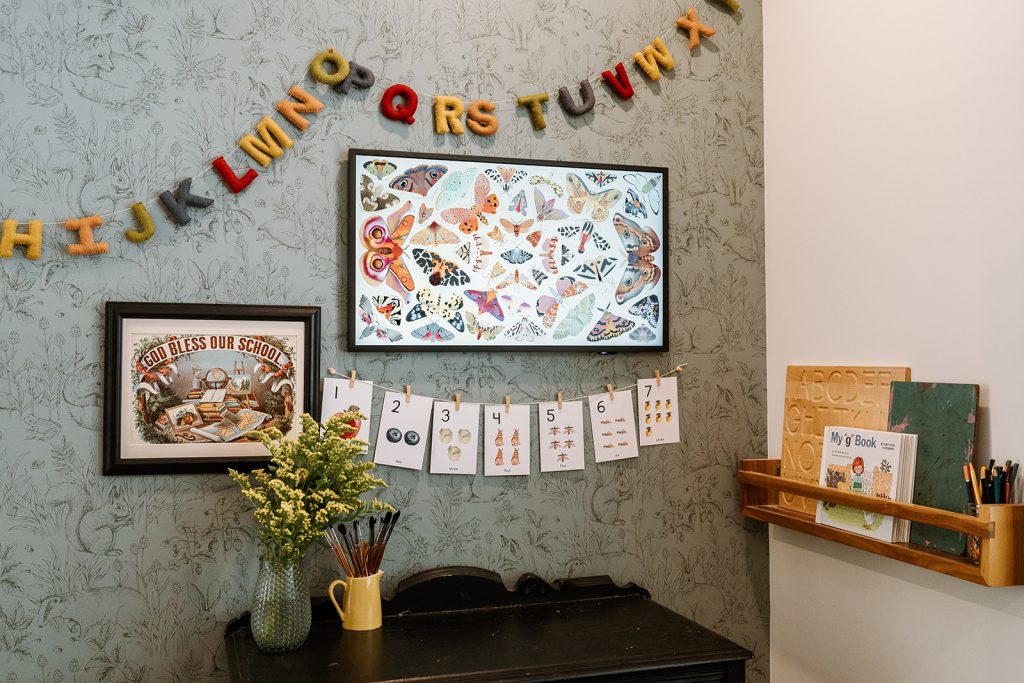
We do math as part of our formal lessons four times a week. Huck will use Saxon Math 1 and Saxon Math 2 this year. Saxon Math uses an incremental approach to instruction and assessment. I like it because it limits the amount of new math principles delivered to students and allows time for daily practice.
First grade enrichment subjects

- Piano (4x per week): Huck will begin taking piano lessons from Hoffman Academy this year. Each day they do a lesson and spend time practicing. We have family recitals for them to share what they are learning every couple of months!
- Typing (2x per week): Huck will do a Keyboarding Without Tears lesson a couple of days a week for typing practice.
- Art and drawing: We do a lot of art and drawing in our notebooking by following online watercolor and sketching tutorials. We also have an Art For Kids Hub subscription and Huck enjoys doing origami and drawing tutorials in his free time.
- Holiday studies: This year we will use A Connected Christmas: Around the World to prepare for Christmas. This includes Bible readings about the nativity story and a look at how the Christmas season is celebrated in different countries throughout the world. We will also use An Expectant Easter to learn about the resurrection in the weeks leading up to Easter.
Other favorite curriculum choices for first grade
When selecting a curriculum for my children, I keep in mind my family’s values, educational philosophy, and my children’s interests and learning styles. Here are some other curricula choices that I would personally recommend.
Sonlight
Sonlight is an all-in-one literature-based curriculum. Their topical curriculum is based on different subjects like Introduction to World Cultures or American History and can be customized to different reading levels and homeschool schedules.
Math with Confidence
Math with Confidence is an open-and-go math curriculum that helps students gain confidence. It includes step-by-step learning along with incorporating movement, games, and real-life learning. It also includes optional enrichment lessons, with suggestions for wonderful math picture books to enjoy together and application activities to make math come alive.
Math-U-See

I used Math-U-See for my older son at this age primarily because of its mastery program for addition and subtraction. The Accelerated Individualized Mastery (AIM) is designed for struggling math students with gaps in their foundational math skills set. The curriculum is mastery-based and allows students to completely grasp one concept before moving on. The curriculum also includes video presentations where math concepts are taught by a teacher.
Beautiful Feet Books
I love the selections from Beautiful Feet Books for literature-based history and geography. Instead of learning through a textbook, this curriculum teaches history, geography, and science through story. You can search by subject and adapt for each grade level.
Dash into Learning
I love using the Dash into Learning Early Phonics Readers as we introduce letters and phonetic awareness at this age. It teaches the very first sounds and sight words to introduce children to reading. It also covers short vowels, blending CVC words, and most consonants.
First grade is such a special year for homeschool families as you begin formal learning. I hope this list is helpful as you make the curriculum choices that are best for you and your child. Share your favorites with me in the comments below.
Favorite homeschool resources from Treehouse Schoolhouse
Homeschool Planner

I developed this homeschool planner to meet my needs as a busy homeschool mom of multiple children. I wanted something simple and beautiful. Customized for Morning Time, Daily Rhythm, and lesson planning, this planner has helped many homeschool moms around the world make space for more beauty and joy in their homeschool.
Treehouse Nature Study, Primary Years
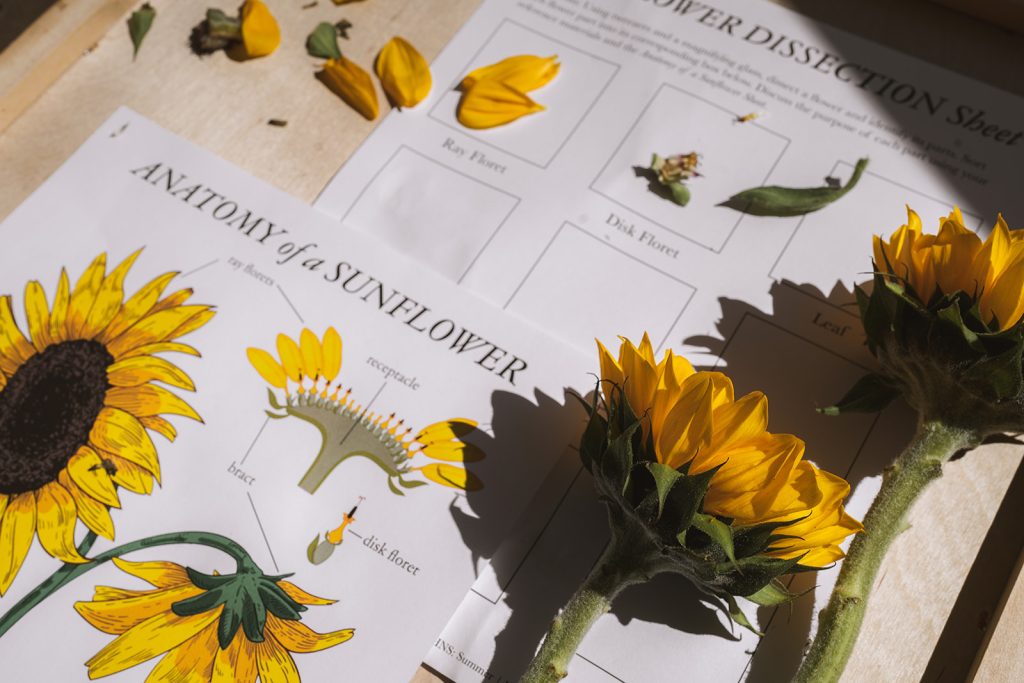
Treehouse Nature Study, Primary Years invites children to connect with each other and the world around them through living books, nature notebooking, hands-on projects, and beauty subjects such as poetry, picture study, and folk songs. From preschool through upper elementary, the study appeals to every age and is easily used with multiple ages at the same time.
It would be a great fit for your preschool or kindergartener’s core curriculum or your whole family’s home education Morning Time and Nature Study. It also provides supplemental work for your children’s language arts through poetry memorization, recitation, copywork, and notebooking.
Morning Time Bundle
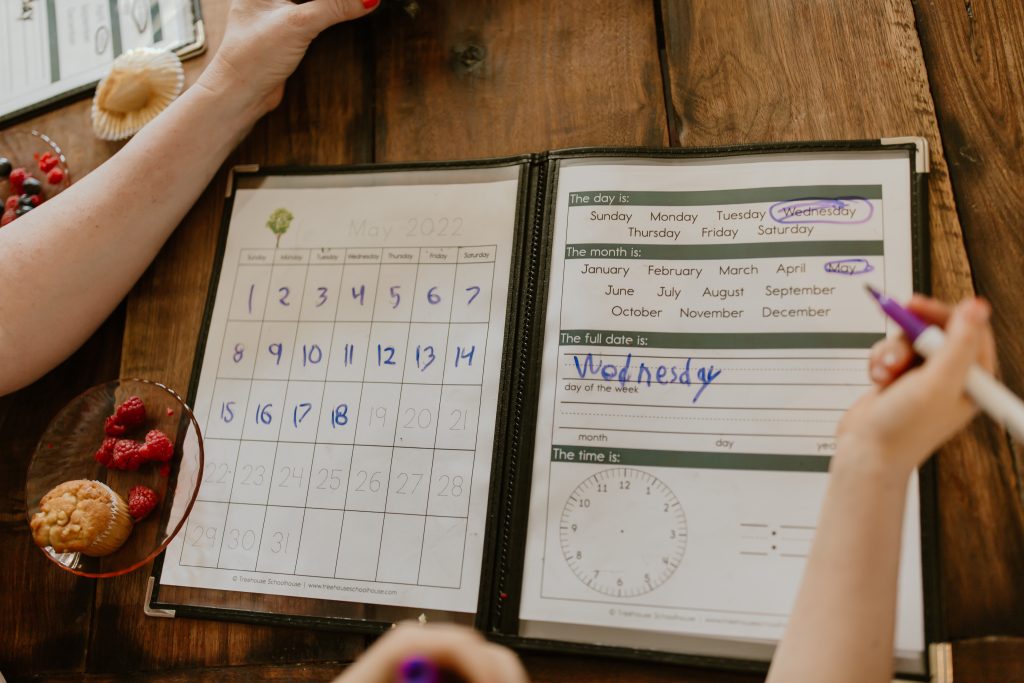
This interactive, reusable set focuses on weather, seasons, moon phase, temperature, weather-appropriate clothing, date and time, and reading a calendar. With this daily bundle, your child will practice the skills of handwriting, tracing, copywork, and telling time. I recommend you print these materials and place them inside of a Morning Time Menu or dry-erase sleeve. Using dry-erase markers, your child can fill this bundle out over and over again.
We also offer a version of the Morning Time Bundle for those in our community who live in the Southern Hemisphere.
Looking for other curriculum recommendations for your homeschool? Read more of our curriculum recommendations below:
- Homeschool Kindergarten: Daily Rhythm, Schedule, and Curriculum
- Favorite Homeschool Curriculum Choices for 2nd Grade
- Favorite Homeschool Curriculum Choices for 3rd Grade
- Favorite Homeschool Curriculum Choices for 4th Grade
- Favorite Homeschool Curriculum Choices for 5th Grade
- Favorite Homeschool Curriculum Choices for 6th Grade
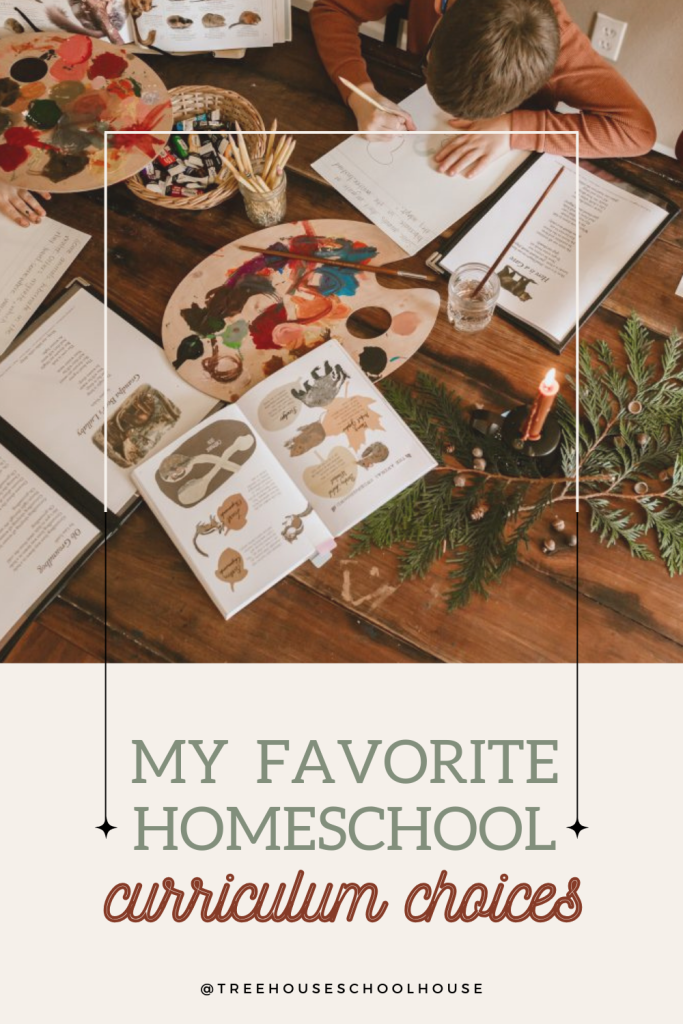


![Winter Solstice Activity for Kids [Free Worksheet PDF]](https://storage.googleapis.com/treehouse-schoolhouse-media-dev/fe547f4b-gn4a7877-scaled.jpg)
